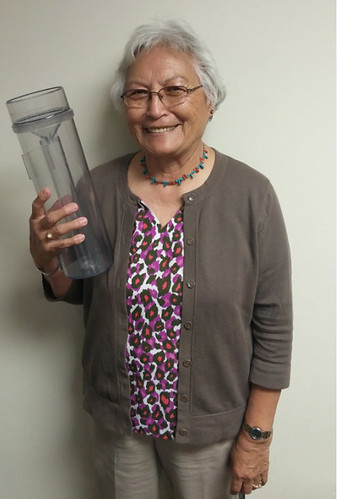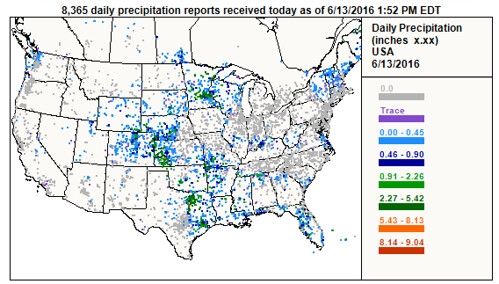
Susie Wauneka has discovered a unique way to serve her community; by watching the weather. Wauneka is a proud member of Navajo Nation and is a Navajo Community Health Representative, providing critical health care services for members of the Nation. In December 2015, she discovered yet another way to serve—by using a Community Collaborative Rain, Hail and Snow (CoCoRaHS) precipitation gauge to track the amount of rain and snow that falls.
The CoCoRaHS network is a unique grassroots network of thousands of trained volunteers of all ages and backgrounds working together to improve meteorological science by measuring and reporting precipitation amounts (rain, hail, and snow). CoCoRaHS is the largest provider of daily precipitation observations in the United States. The data from these observations are used by USDA and the National Oceanic and Atmospheric Administration (NOAA) for tools such as the United States Drought Monitor.
Like many weather-monitoring projects, CoCoRaHS was borne out of a disaster, the Spring Creek flood that struck Fort Collins, Colorado in July 1997, killing five people. In response to the flood, a team at the Colorado Climate Center at Colorado State University led by Nolan Doesken, developed a network of volunteer observers along the Colorado Front Range. During the 2000s, CoCoRaHS expanded beyond Colorado to become a national network, even reaching the White House that joined CoCoRaHS in 2015 using a gauge monitored by the National Park Service.
"Precipitation is our water supply," said Nolan Doesken, State Climatologist for Colorado and the founder and director of CoCoRaHS. "What falls from the sky varies greatly from year to year and also from place to place even just a few miles apart. Volunteers do a fantastic job of helping track precipitation locally and nationally. The more volunteers who help out, the better we can track and appreciate this critical resource.”
In March 2016, President Obama issued a Presidential Memorandum on Drought which outlined six goals to better coordinate Federal support for drought-related efforts, help communities reduce the impact of current drought events, and prepare for future droughts. Goal One focuses on data collection and integration and outlines the need for the Federal government to better facilitate Citizen Science initiatives throughout the country. In carrying out this goal, USDA and NOAA have been working to expand the reach of CoCoRaHS gauges into the Southwest, a region typically data-sparse.
Recently, with funding from the Natural Resources Conservation Service, USDA purchased 72 CoCoRaHS gauges for Navajo and Hopi Tribal lands. The gauges were delivered by National Weather Service (NWS) Scientists to Navajo Nation chapter houses and to the 15 villages on the Hopi Reservation. NWS staff have begun to train volunteers to accurately report precipitation. Susie Wauneka is just one of the observers whose measurements now contribute to filling the data gap in the Southwest.
Through the expansion of the CoCoRaHS initiative, USDA and NOAA are engaging citizens in the process of collecting data and ultimately working to create more drought-resilient communities. Community and tribal leaders throughout the Southwest now have the opportunity to help our nation become more drought resilient through better data.
For more information or to become a CoCoRaHS observer please visit http://www.cocorahs.org/.

